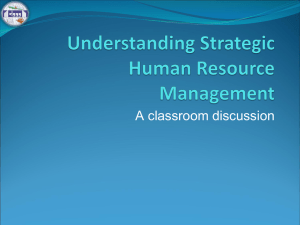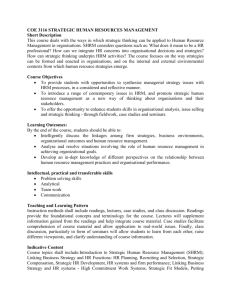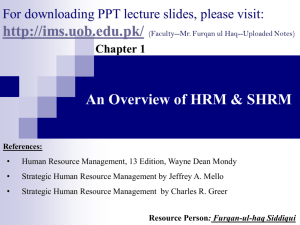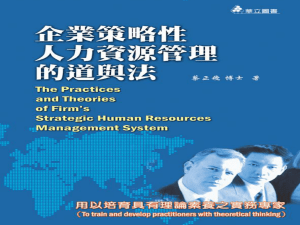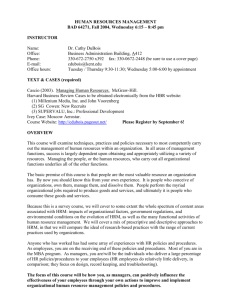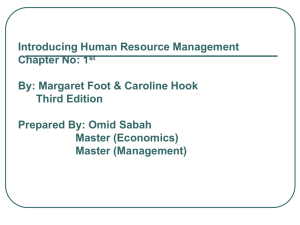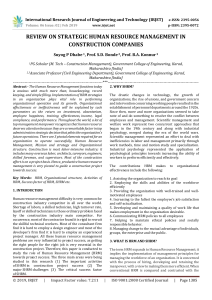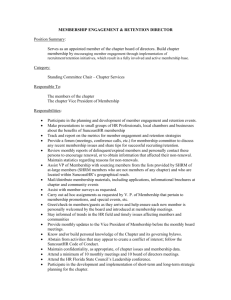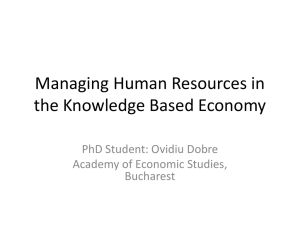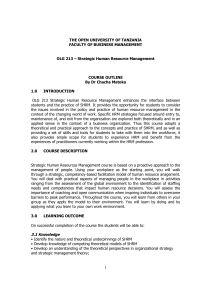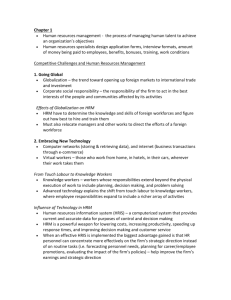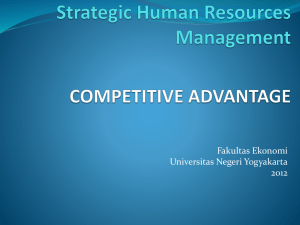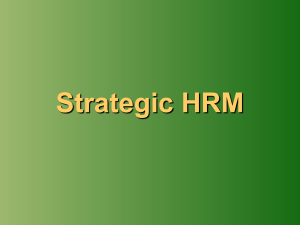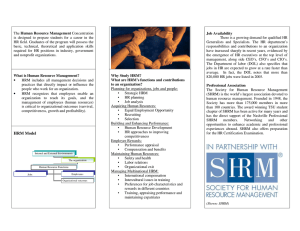Strategic HRM: A North American Perspective
advertisement
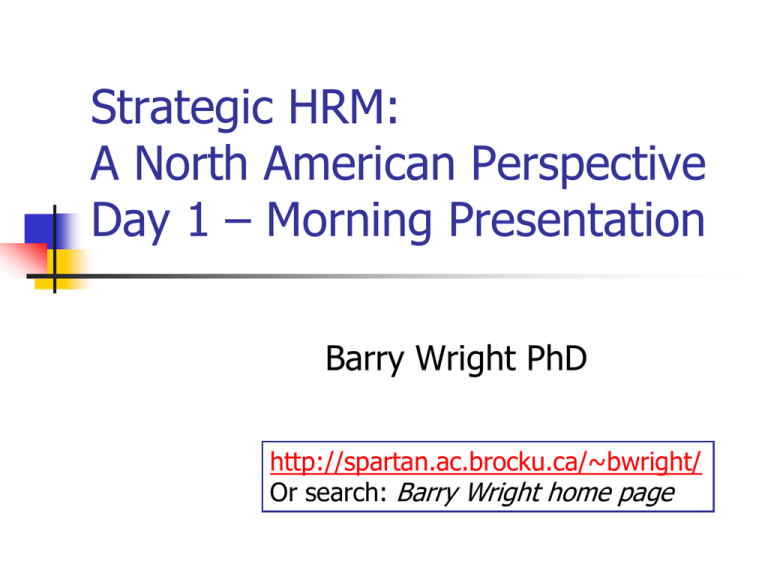
Strategic HRM: A North American Perspective Day 1 – Morning Presentation Barry Wright PhD http://spartan.ac.brocku.ca/~bwright/ Or search: Barry Wright home page Course Format Monday, Tuesday, Wednesday Format 9:30 – 12:45 p.m. 2:00 – 5:15 pm Lecture, Group Work, Presentation /Discussion Marks Case Write-ups (group) 3 @ 10% = 30% “Company” report (and presentation) 40% Individual “Insight” Journal 30% Format of Course Lecture, small group discussion, large group discussion, group work, group presentations Morning Afternoon 9:30 – 10:30 a.m. Lecture 2:00 - 3:00 p.m. 10:30 – 11:00 a.m. Group work 3:00 – 3:30 p.m. 11:00 – 11:30 a.m. Break 3:30 – 4:00 p.m. 11:30 – 12:00 noon Group work 4:00 – 4:30 p.m. 12:00 – 12:30 p.m. Presentations 4:30 – 5:00 p.m. 12:30 – 12:45 p.m. Wrap-up 5:00 – 5:15 p.m. Presentations Small group work – groups of 5 or 6 – depends on number of students in class Given a case / problem and question to answer Typed hand-in (short – 1 or 2 pages) and a possible in-class presentation summarizing your group’s thoughts Question and Answer following presentations Marks A – Outstanding (9-10) B – Very good (7-8) C – Acceptable (5-6) F – Failure (4 or below) Company Report Your group will choose an organization and do an assessment of their Strategic HRM practices. Most information can be found on the internet including company annual reports (with a little searching) Key to the assignment is to critically assess their SHRM practices Tell me what they are doing by comparing the company specifically to what we are covering in this course. Make recommendations for change (where needed). Company Report Introduction – provide and overview of the company Discuss their SHRM practices Draw from the Seven practices and Four R’s Recommendations (3,000 words) Draw from the Seven practices and Four R’s Conclusion Insight Journal I want your to personally reflect on the material covered in the course; generally, reflect on one key point from each lecture (four different entries). For each entry: discuss one ‘thing’ you found interesting; relate it to something in your work past to demonstrate your understanding; then discuss how you will draw from this interesting point to help develop your HR leadership actions in the future. Length of insight – I would expect at least one-half page per entry but overall you decide how much you will provide. Class Leadership Please make a “sign” with your name on it – this will allow me to connect you with your class leadership Task: the “HR Story” thus far 1. Bring me an “up-to-date” on what SHRM courses and experiences you have had so far. Time – 10 – 15 minutes Course Outline Monday Introduction, Past-Present-Future, Seven Practices Recruitment – selective hiring Tuesday Retention – employment security, status reduction, comparatively high compensation CASE: Howe 2 Ski Rouse – loyalty, commitment – self-managed teams, decentralized decision making, diversity CASE: Getting Better Applicants CASE: Attitude Survey Wednesday Redevelop – training and development – at all levels Group Presentations Janusean Thinking In ancient Roman religion and mythology, Janus is the god of beginnings and transitions He looks to the future and the past Research – deeper you reflect on the past – further you can see into the future North America The Old Paradigm At the start of the 20th century, the North American economy is relatively self-contained and immune from foreign competition The employment is full-time, long-term, and relatively stable; the typical workplace is a large firm The corporation is a stable sovereign organization with a clear division of labor Everyone abides by the “social contract” The Old Social Contract Permanence – in the employer-employee relationship, i.e. long-term job security Entitlements – to a job, a steady pay advancements, and generous benefits Paternalism – the company is viewed as a ‘family’ by employers and employees Hierarchy – lines of authority and levels of status are clearly defined; clear division of labor Human Relations Following the “Hawthorne experiments,” many managers accepted the basic idea that workers responded not only to economic inducements but also to psychological and social influences Quality of Work Life (1950s) Growing disaffection among workers with unchallenging jobs and heavy-handed management prompted managers to rethink the way work was organized and managed Recessions, deregulation, and mounting foreign competition brought considerable pressures to bear on managers. Management learned that quality, not only cost, was a key to market success. New initiatives, such as self-managed work teams, increased the value of people to management, (hence the shift from the term “personnel management” to “HRM”) and opened the door to a new conceptualization of how work is organized and the role of HR specialists TQM, Reengineering, & Globalization (1980s) Trying to stay competitive, many companies took up Total Quality Management and reengineering. HR departments became more focused on serving both external and internal customers, lowering costs through process improvements, and facilitating organizational change and organizational learning initiatives Recent Developments Profit / Customer focus – companies looked to HR departments to take more long-term, profit oriented perspective; HR is a source of competitive advantage New Technology – new technology allowed outsourcing of many activities and handling many administrative aspects of HR electronically; firms focus more on “core competencies” Recent Developments Diversity – HR were asked to reconcile the social demand that employment practices be open and inclusive with respect to diverse cultures and lifestyles and the need for highperforming, employees Globalization – Global trade and global capital mobility increased dramatically in the 21st century; labour force contraction in NA Lessons Learned Profit calls the tune – profit is the invisible hand that guides and shapes all aspects of company’s HR practices Strategic – the more that labour issues have the potential for impacting the bottom line, the more that top management will start to look at HR from a strategic perspective Deregulation – has resulted in declining unionization and wages in industries Lessons Learned Contingency – HR practices that work well for one company or in one situation may be an embarrassing failure in another (don’t just follow the leader) – it depends on your organization’s strategy (low cost producer vs. differentiator) Alignment - management must adopt a holistic, systems view of HR and mix and match HR practices so they interact with each other to maximize overall performance Human Resources are people – every person wants to be treated with respect and fairness A New SHRM Model High Performance Work System Innovative Work Practices High-Engagement Model High-Commitment Model Two Work Systems HRM Practices Command & Control High Performance Internal career opportunities Hiring mainly from outside the firm Very little use of internal career ladders Hiring mainly from within the firm Extensive use of well defined career ladders Training No formal training provided Extensive formal training provided Result-oriented appraisals Performance measured by quantifiable output Performance measured by behavior-oriented measures Incentives Mainly extrinsic Extrinsic and intrinsic Little High Benefits to outpaced employees Formal dismissal policies Participation in decision making Little High Job descriptions Jobs are clearly/tightly defined Jobs are broadly defined Employment security HRM Reality Implications Employers (The 4 R’s) Recruiting – Get the best Retention – Keep them Rouse - Keep them motivated and empowered Redeveloping Skills – Keep their skills current Task Form teams (5 or 6) Read Pfeffer article (Seven Practices) Select your Company Be sure there is lots of information on the company.
